Edible Cladonia: What’s not to Lichen?
Lichen can be harder to tell apart than twins in the dark. My guess my picture above is of Cladonia Evansii (kla-DOE-ne-ah ev-AN-see-eye) which is a southern version of a common lichen that came down the Appalachians. It takes a lichenologist to know for sure, but fortunately lichen are not like mushrooms. While 96% of the 10,000 species of mushrooms are not edible (including the one to four percent that will definitely kill you ) only two lichen out of some 20,000 are what we would call poisonous, Letharia vulpina (leth-AH-ree-a vul-PEEN-ah) and Vulpicida pinastri, (vul-pis-EYE-dah pin-AST-try or wol-peek-EE-dah pin-ass-tree)) or Wolf Lichen and Powdered Sunshine Lichen… and conveniently they are both yellow, Wolf Lichen a greenish yellow and the Sunshine Lichen a sulphur yellow. And though internally toxic from vulpinic acid they can be used on external wounds and sores.
Most lichen are likable, but not exactly consumer friendly. What the lichen all share is acid and as such require proper preparation if they are to be eaten because unprepared and uncooked they will painfully attack your digestive track. Unprepared lichen taste like aspirin. That should motivate you to prepare it correctly. Never eat unprepared and raw lichen unless your life truly depends upon it. It probably will not kill you but you will wish it had.
One of the most widespread and commonly eaten lichen, by beast and brute alike, is a northern version of what you see above, Cladonia rangiferina, (ran-jiff-er-EYE-nah or ran-ghif-er-EE-nah) also known as Cladina rangiferina — both Latin for many branching reindeer like. That’s rather clever since reindeer eat a lot of it and its branching resembles deer antlers. C. rangiferina, however, stops its southward migration in the United States with the end of the Appalachian Trail. I can remember as a boy, living on the northern end of those mountains in Maine, not only playing with C. rangiferina but running through brittle beds of red-topped Cladonia cristatella . You could actually leave foot prints in the lichen like those left in snow… and unknowingly crushing centuries of growth at the same time.
The two common “reindeer mosses” found here in central Florida are the Cladonia evansii and Cladonia subtenuis, with the subtenuis — which means thinner — being less compact than Cladonia evansii. C. evansii — named after North Carolina botanist Alexander W. Evans — has no official common name but it is called Powder Puff Lichen. C. subtenuis is called Dixie Reindeer Moss.
There are three surprising things about lichen. The first is lichen is a symbiotic relationship of two life forms, fungi and algae, with the fungus providing the form and the algae the operating system inside. That seems a lot more understandable than the creature normally used to explain symbiotic relationships, the Portuguese Man of War. It’s called a jellyfish but is really a colony of different life forms, one group whose job is defense and they sting painfully. Lichen are more likable. Heck even 50 or so species of bird use lichen for their nests. If ya can’t eat it, sleep in it. By the way, it burns readily and makes great kindling, or a small hot fire.
The second surprise is folks used to make a lot of booze from lichen. For about 50 years in the 1800’s Sweden led the world in lichen alcohol production with the rest of Europe and Russia joining in. It was viewed as an alternative to grain alcohol. Lichen brandy was a big hit, and it was also used in the making of Akvavit, a traditional caraway-flavored spirit. That said, I have to run off on a non-plant tangent here for a moment.
Akvavit comes from the Latin phrase Aqua Vite, which means “water of life.” The Irish word “whisky” is from the same Latin phrase and means the same thing: “water of life.” Akvavit/whisky…aqua vite….The obvious conclusion is the Irish spoke ancient Latin with more of an accent than the Scandinavians. Now, from a marketing point of view, you read it here first: They should reintroduce lichen into their Akvavit. Lichen is grown commercially in Scandinavia. It would make for great branding. Can’t you just see a clear vodka-like bottle with a lichen-esque label, maybe some stately lichen on some craggy gray rocks, maybe even a flak or two of lichen in the bottle…. it has to cost less than gold flakes….
Anyway…. Not only were lichen used to make alcohol but Russia managed to make a molasses out of it. I’m surprised the Russians didn’t try to make rum. That alcohol and molasses could be made from lichen highlights their third interesting aspect: Most lichen, including most of those you see on trees, rocks and old cemetery stones, are some 94% carbohydrates. That’s some 14% more carbs than a potato. But, along with those carbs is a lot of rock-dissolving acid that can burn your insides, which is why they have to be prepared a certain way.
The amount of acid varies from species to species with the Cladonias, especially C. rangiferina, being among the most nutritious and the least acidic. A combination of nutritional studies suggest Cladonias are, by dry weight, 1.4% ash, 5.4% protein, 32.9% fiber, 2.1% fat, and 0.501% niacin 3.7% calcium, and 0.09% phosphorus. They also have vitamin A. Fiber, carbs, vitamins and protein. Maybe the Scandinavians of old were on to something.
In a severe survival situation lichen can be eaten unprepared and uncooked. You will survive but you will also have a severe stomach ache that will make you want to die. The amount of carbs per lichen species and its availability varies. To make the lichen edible they are soaked in several changes of water, better, several changes of water with bicarbonate of soda added to each soaking. Another method is to soak them with hardwood ashes. The modern version of that is to soak them in a 1% solution of potash. A method used in China is to boil lichen for 30 minutes and then soak for two days in several changes of water. After discarding the soaking water they are boiled and that water discarded, or they are steamed. They are then ready to eat, plain or mixed with other things, or dried and added to flour or as a thickener to soups. Lichen is often cooked until it turns into a gelatinous mass. My mother remembers her mother using prepared lichen to make a pudding, probably as a thickener. Cladonia islandica was used to thicken jelly until gelatins came along. The point is the longer you soak them and the longer you boil them and the more often you change the water the more palatable they will be and the less acidic.
Yet another way is to take about three cups of lichen, cover with water, add about a quarter cup of bicarbonate of soda (sodium bicarbonate aka baking soda) put on a stove and bring to a boil and boil for about 15 minutes. Drain, replace the water, replace the bicarbonate of soda, again bring to a boil and boil for about 15 minutes. Drain, rinse, barely cover the lichen with water and bring to a simmer can cook until it is gelatinous. It is then edible but not greatly palatable.
Oh….You can also eat any lichen you find in the first stomach of a reindeer, but it’s messy and not too good tasting. To get around that you freeze the stomach and its content. Then you slice it off and put it in stews and the like. There it is far better, but not five stars.
I saw forager Dick Deuerling nibble on Cladonia evansii uncooked while out on the trail, just picked it up, crushed some in his hand and down it went. One also told me he just crumpled it up and dropped it into soup. Woodsmen in northern Canada reportedly used rock lichen to make a “stimulating” tea by boiling it for 15 minutes. I suppose a stomach ache can be stimulating.
One point to consider is whether to eat lichen at all in populated areas. Lichens grow very slowly, one or two centimeters a year, and can live to be three thousand years old, and can stay in tact another 10,000 years. The lichen you may be thinking of partaking could be older than you are or was alive when the ancient Greeks were. Lichen can also collect a lot of pollution in those years. It just might be that it is good to know one can eat lichen but one doesn’t have to. In fact, they take very well to dish gardens and don’t have to be watered. They get all the moisture they need out of the air. It’s a pet that can outlive your parrot, and it talks less, too.
There are actually five different kinds of lichen: Those that grow in clumps as the one shown here, those that grow in flakes commonly seen on trees, crust lichen, often seen on cemetery stones, lichen that looks like a combination of flakes and crust, and a class called Leprous for powdery patches (so named by the ancient Greek Dioscorides because they resemble the lesions of leprosy.) Here are some more lichen that are commonly eaten.
Gyrophora, aka Rock Tripe; Umbiliceria, also aka Rock Tripe, mucilaginous, used for thicken, has antibiotic properties; Historical Note: George Washington’s troops had to eat rock tripe during the deadly winter of 1777 at Valley Forge. Lecanora, aka Cup Moss, Manna, can be broken apart by the wind. This is the lichen mentioned in the Bible when it showered starving Israelis with “manna rain”; Alectoria, aka Black Tree Lichen, Indians steamed it for two days in pits, was eaten or dried and powdered for mush or thickener. Also eaten are Evernia, Sticta, Umbilicaria esculenta, Peltigera canina, and Aspicilia esculenta.
Usnea is also edible but is more valuable as an antibiotic and antiseptic (see separate entry.) In fact, it it estimated that 50% of all lichen have medical applications but Usnea are especially good externally on wounds and the like. Usnea lichens have an elastic white chord running through the center of the main stem. Lichen that resemble Usnea do not have this white cord. They also appear grey-green throughout. Also Usnea lichens do not change color during the growing season whereas lichen which closely resemble Usnea do. If you’re in the southern US and you think you’ve found Usnea and it has a black hair through the middle you’ve found Spanish Moss. Spanish Moss is not edible but does have some medicinal applications.
There are two versions of how the word lichen came to be, both of them from the same Greek root. λειχω (LEAK-ho) means to lick and λειχην (leak-NEE) is an eruption. In modern Greek λειχην is what herpes is called. Theophrastus (371-284 B.C.), a Greek botanist, used the term to describe superficial growth on the bark of Olive trees, as if it had been licked up. The second version is that flaky lichen looks like it is licking rocks and trees and were named lichen by botanist Joseph Pitton de Tournefort in 1700. He was on a two-year trip to Greece, which at the time was enslaved by Turks, a slavery that for Greeks overall lasted over 400 years. To demonstrate how the Greek linguistic ear works, LEAK-ho is to lick and GLEE-ko is sugar, or a sweet lick.
As for exactly how many toxic lichen there are, well, two for certain, and maybe a 100 more. No one really knows. But, if the lichen you are looking at has any yellow parts, or is yellow, it is best not to eat it. That easy to remember.
Lastly if you are not inclined to eat lichen, especially those found on cemetery stones you can use the lichen to calculate how long the stone has been in the cemetery, a useful genealogical tool if the date is worn off, as is often the case with marble. To calculate, measure the lichen in centimeters from a center point to the outside edge, then multiply by five and subtract the total in years from today to get the latest date that the gravestone could have been made. The size of the lichen directly reflects how long the stone has been exposed and is a common dating technique of natural events.
For the curious, here are two recipes using C. islandica (called Icelandic Moss.) Below the “profile” is an except from the Journal of Economic Botany on how they made mollasses out of lichen.
Icelandic Lichen Flatbread
1 packed cup Icelandic moss (C. islandica after soaking)
1 1/2 c rye flour
1/2 c stoneground whole wheat flour
a pinch of salt
Boiling water as needed
One cup soaked Iceland moss is about two cups dried.
The Icelandic moss is soaked for a few minutes in lukewarm
water to soften it, then drained and chopped. Mix it with rye
flour, wheat flour and salt, then gradually add boiling water
and stir well, until you have a stiff but pliable dough. Divide
it into 12 equal pieces, roll them out thinly and cut out a
round cake, 7-8 inches in diameter. Prick them with a fork.
Cook on a griddle or bake at high heat until black spots
appear, then turn over and cook the other side. Store in a
damp cloth or plastic bag because they dry out quickly.
Lichen Milk Soup
a large fistful of prepared Icelandic moss (C. islandica after soaking)
1 litre (4 cups) milk
1 tbsp sugar or brown sugar
salt
Prepared the lichen then dry it. Pour the milk into a saucepan and heat to the boiling point. Add the Iceland moss and the sugar and simmer for 10 minutes. Add salt to taste and serve. In another version, the soup is simmered for 2 hours, until somewhat gluey. Some versions add far more sugar but that is not traditional.
Green Deane’s “Itemized” Plant Profile
IDENTIFICATION: Cladonias: Spongy, grayish mass up to 4 inches thick forming extensive mats three or four inches high, or clumps. Richly branched, each branch dividing into four, with the main branches distinctly curved in the same direction. Looks like the tubes inside a lung
TIME OF YEAR: Year round
ENVIRONMENT: Well drained open areas, sandy scrubland in Florida, prefers acid soil, Alpine environments in the north. It grows where other plants will not and for virtually thousands of years so it can often be quite polluted including nuclear fall out. Choose carefully.
METHOD OF PREPARATION: Must be soaked/boiled in copious amounts of water, or water with wood ashes or water with sodium bicarbonate or potash to get rid of acids. Then it can be added to various foods, wet or dry but must be cooked well.
From the Journal of Economic Botany Vol. 10 #4 pp 367-392, 1956 by George Llano.
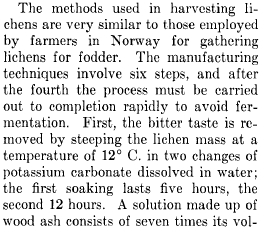
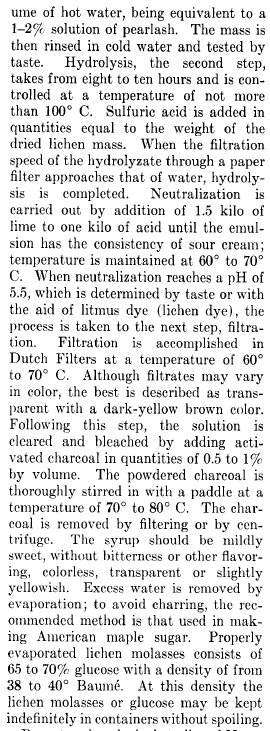

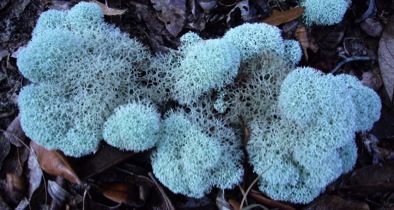
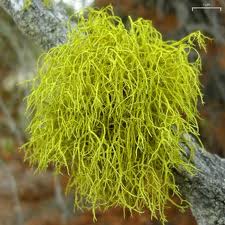
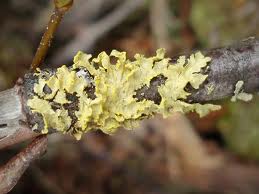
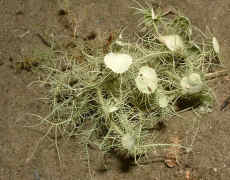


I’ve watched many of your videos and I am very glad to have you in my pool of resources for foraging, both your youtube videos and this web site. Thank you. When it comes to lichens, though, there’s really not a lot of proper knowing around. That’s to be expected, of course, when a resource hasn’t been utilized much for such a long time. Here are some of my very own first hand experiences: Rock tripe, I’ve mostly eaten a black and grey type with blisters but also a leathery type with a black, velvety underside, does not contain any detectable amount of acid. Can be eaten raw, but I like to boil it for two minutes. Has a pleasant, rather bland flavour somewhat like dumplings. Dark old mans beard contains a good deal of acid and causes cramps – I was stiff as a needle for several minutes after forcing down a whole plate of it only boiled, very stupidly. Certainly needs treating with ash water or by other method. Yellow old man’s beard is even more acidic and really tastes like aspirin. I don’t concider this one food. Ate a little every day for a month and half in India and maintained proper bowel (for the first time :-)).Reindeer moss also has a very bland flavour when eaten raw, but is extremely tough to chew. Have made flour from it and green scones. Mushroomy flavour. I did treat it with ash water, but not sure it was neccesary. Have yet to boil some and see if water tastes acidic, in case the acid is there but I can’t get to it by chewing. Iceland moss is not acidic, but very bitter. Needs treatment for palatability.
I would really like to ask you about Your geographic location and get into some more particulars about your experience/methods of preparing rock tripe. You claim you eat it raw…95% of info on the Internet comes back that you are supposed to leech it. A few state as you do. Personally I have tasted it raw(non consumption) searching for anything offensive and found it quite palatable, which makes me curious. Also, Green Dean, I’m not sure how the notifications work for your site, or if this gentlemen will be able to see my query, but, if he can’t, would you be able to act as a segway? …anyway, thank you deeply for such an informative and we’ll written site, you are an invaluable resource.
Do you know where I can find a recipe for Lichen alcohol? Thanks for the article!
Thanks for the informative and well written article on Lichens. I enjoyed the read. There is one fact which is not accurate. You state that 96% of mushrooms are inedible. Even if all chewy and unpleasant flavored mushrooms are included, the number is way lower than that. Edible mushrooms that are mediocre or better are somewhere around 30%. Actually poisonous species is also probably around 30% but I’ve seen estimates as low as 18%.
Thanks for taking my comment,
Kelly Chadwick
With mushrooms (all fungi included) it depends on which expert you choose to quote.
Great article but one small mistake…the “Irish” word for whiskey is actually the Scottish word for whiskey. In Scottish Gaelic it’s Uisge Beatha, pronounced “wishga bayha” meaning water of life. Most people only say the Uisge part (whiskey) so really they are just saying water.
Irish Gaelic (Gaeilge) isn’t too different. The Irish word for whiskey is “uisce beatha” (pronounced ishka baha) so it’s just slightly different.
I have eaten rock lichen many times – both raw and cooked. Never gave me a stomach ache. Tastes like dirt, but it has trace minerals devoid in most of our foods. I put a little in soup or beans a few times a year. I always harvest the lichen that has been blown off the rock face by storms and not off the rocks itself. Wash well for grit and discard the little hard knot where it attaches to the rock.
Thanks for adding to our knowledge.
Thanks for all the info on lichens, I’m a manager on the Board Of Island Managers of Burlington City, N.J., the oldest non profit educational charter in the entire U.S.A. est. 1682. I maintain the trails on our 400 acre natural island in the middle of the Delaware River. In the fall I can harvest plenty of lichen, since we are a non profit, I’m always looking for ways to help generate $ thru fund raising, is there a way to do that by collecting and selling our lichen? Your help will be greatly appreciated.
I am interested in eating the lichens, and noted the Cladonias is “reindeer moss.” Saw a site claiming it was toxic is one does more than drink just one glass of tea from it, but figured that you were right, boil it, and pour off the water, re-boil, and it will not cause nausea. Just interested to know. I assume that you have eaten a meal size amount, would like to know more. What source of info on lichens in the U.S. are there? We have a lot of the gray kind here, the shorter flat gray kind and the deer moss, such as the photo you have of the reindeer moss, and did see the yellow and knew that it was not the edible kind… Just wandering how much can one eat, and how to prepare it. I saw a short bit about Canadians used to use “old man’s beard,” and grind it into flour. How can I find out more info, especially for lichens in Tennessee? carriegerenscoggins@gmail.com
I have eaten some. I have not eaten a “meal-size” amount. Never occurred to me, really. I view lichen as a small addition to a main meal.
Is mood moss edible? Could I put in my water and drink through it or serve food on top of it??
As far as I know Dicranum scoparium is not edible.
Hi Green Deane, I am looking to contact you. If possible could you kindly let me know your contact number or call me.
Many thanks.
Regards,
Subodh Gupta, Ph.D., P.Eng.,
Calgary, AB
(403)6057525
I am looking to make a lichen pudding…do you know the recipe for that?
You have mentioned that C. islandica, but it doesn’t look like you have clarified this is a different genus: Cetraria islandica. This is totally different type of lichen than Cladonia, it is a foliose lichen in a different family than Cladonia sp. and looks quite different. It would be good to clarify.
Awesome article! I think that dagad phool would be of good mention here as well. A delicious lichen long used as a spice in India (see recipes for goda masala).
Dear Sir or Madam
I am justin wong working for Guangdong Yuanfeng Craft Co.,Ltd which has specialized in preserved reindeer moss,mood moss,sheet moss and preserved reindeer moss panel with over 10 years experiences and competitive price in china.You can supply your OEM requirements to us to customize.We can supply the best quality products and services to you all the time.Thank you.
Free sample factory 8usd/500g preserved reindeer moss from our factory